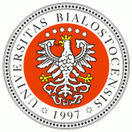Sponsors:



 |
|
Organized by
the Institute of Experimental Physics, University of Bialystok
Davide Boschetto, France
Excitation and detection of coherent optical phonons
D.Boschetto, Laboratoire d'Optique Appliquée, ENSTA-Ecole Polytechnique,
Chemin de la Huniere, 91761 Palaiseau cedex, France
-
The elementary modes of atomic vibration, called phonons, represent the first response of the lattice to an external excitation, and play an important role in the description of phase transitions and the related structural displacements. The time scale of such oscillations depends on the phonon branch (optical and acoustical). Optical phonons near the centre of the Brillouin zone evolve in the 100 femtoseconds (1 fs = 10-15 s) timescale while acoustical phonon have much longer period of oscillation. The characterization of phonon dynamics and the control of its excitation using an ultrafast laser pulse can pave the way to a fully driven structural phase transition.
This lecture is divided into two main parts:
- Coherent optical phonon excitation: The mechanisms of coherent optical phonons excitation is shown and classified with respect to the optical properties of the crystal, mainly if the crystal is absorbing or transparent at the excitation wavelength. Beyond this, the dynamics of photo-excited electrons and the rule of electrons-phonons coupling are explained in the light of a two-temperature model.
- Detection of coherent optical phonon: The time resolved detection of coherent optical phonon is the best way to measure the lattice dynamics in real-time, eventually together with the electrons dynamics. We will focus our attention on two main wavelength ranges for probing the crystal: visible light and hard X-ray. Probing the sample with the former allows the detection of both lattice and electrons dynamics. However, visible light is not sensitive directly to lattice dynamics, and therefore no quantitative measurement of the phonon dynamics can be done. On the other side, the X-ray wavelength (~1Å) is of the order of the inter-atomic distance, and it is therefore the most appropriate tool to make a quantitative measure of the lattice dynamics, especially using femtosecond X-ray diffraction technique. The coupling of these two techniques will allow the knowledge of the full crystal dynamics associated with phonons generation.
Finally, a discussion is presented on the relationship between some phase transitions and phonon-dynamics.
|
|
|